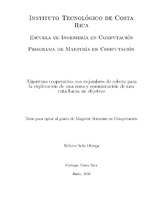Algoritmo cooperativo con enjambres de robots para la exploración de una zona y comunicación de una ruta hacia un objetivo.
Resumen
This thesis explains the development, design, simulation and physical implementation
of a cooperative algorithm to be used by a swarm robotics in order to explore an area
and communicate a route to a target. Furthermore a partial physical implementation
of the algorithm is performed in order to test the feasibility of the implementation.
This algorithm allows independent and decentralized organization of a swarm of agents
through local and direct communication with the environment in which they operate.
For the development of the algorithm a scheme that involves virtual footprint, better
known as pheromone was used. These allow agents to communicate with the environment
and take conscious decisions base on these foot marks.
Two types of pheromones was used: repellents and attractants. The repellents are released
by the agents when they are in search mode and indicate to other agents, areas that
have already been explored. On the other hand, attractant pheromones are released
once the agent or has reached the goal or hit a sector where this pheromone is found,
this in order to communicate the path to the target.
The algorithm is based on the theory of cellular automata to determine the states and
decisions of the agents according to the state of their immediate environment.
Finally, a construction of 5 physical robots was made to test the basic algorithm for
scanning an area on a scale environment
Descripción
Proyecto de Graduación (Maestría en Computación) Instituto Tecnológico de Costa Rica, Escuela de Ingeniería en Computación, 2016.
Compartir
Métricas
Colecciones
- Maestría en Computación [119]


